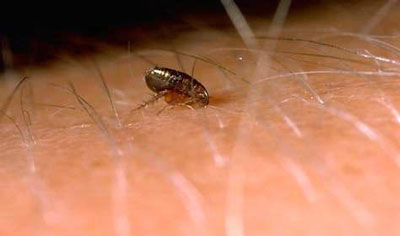Protecting against fleas, and coping if you don’t…
The country might be running out of money and jobs, but it will never run out of cat fleas. Unless you want to start your own personal flea circus, you might want to prevent your cat from getting infested with the little critters. You might also be itching whilst you read this, wondering how to get rid of unwanted lodgers. If so, read on…
Feeling itchy already?

To answer the above question, I’m itching as I write this. Thankfully, it’s all in my head. There are absolutely no fleas in the vicinity.
Regardless of that, if you own a cat or dog, it’s more or less inevitable that at some time or another they’re going to introduce you to their newly-found friends; the Flea family. If you’re really unlucky, the Flea family might bring along their cousins, the Tapeworms. If this happens, an ASBO won’t do the job. You’ll need to resort to chemical warfare. Still, let’s backtrack for a moment.
Your cat may be the cleanest kitty within a 3000 mile radius, but that won’t stop him or her from stopping for a chat with the cat that lives in the dustbin in the street behind yours. And picking up a couple of hitch-hiking fleas. We know that if the fleas make it to your home, they’ll set up shop faster than an army of travellers in an unlocked field.
After fleas hop onto your cat, they will want to eat, mate and then lay eggs. The bite will probably irritate the cat, but the fleas laid in its fur are the real problem. Those fleas, if viable, will either get eaten by your cat during grooming, and so risk giving the cat tapeworm, or will fall off on your carpets and furnishings. These eggs quickly become larvae, pupae and, finally, adult fleas. In your home. These new arrivals then do their best to emulate their parents, and have their own kids. Sooner than you can blink, you’ll have more fleas than bills.

What to do?
Plainly, the best course of action is to treat your cat before it’s too late. Flea collars were very popular in the past and are still used now. They are impregnated with active ingredients such as permethrin or other pyrethroids, organophosphates, carbamates or flea-growth inhibiting substances such as methoprene. Some people swear by collars, others don’t rate them as being effective. What is true is that the chemicals generally don’t spread across the cat’s coat, so aren’t always effective. Some cats respond badly to collars and hair loss can occasionally occur underneath the collar, so keep an eye on your cat to see if it starts having problems. If you choose to use a flea collar, check that it has a snap-open safety release so that your cat can escape if the collar gets caught on something.
So-called ‘Spot-On’ treatments are increasingly popular and recommended by most vets. These are treatments which are applied in little drops, directly onto your cat’s skin. Some of the more well-known are ‘Advantage’, ‘Stronghold’, ‘Advocate’, ‘Frontline’ and ‘Promeris’. Most are available only from a Vet. If used regularly, these treatments kill fleas on your cat and prevent any eggs laid from developing into adults. These ‘spot-on’ treatments are, in our opinion, the best way to prevent fleas. Not all ‘spot-on’ products are the same, so check with your vet that they do what you want.
If you’re concerned that your cat already has fleas, but haven’t actually spotted any yet, one way to spot their presence is to comb the cat meticulously with a fine-toothed flea comb over a clean white surface, like a piece of paper. Fleas and ‘flea dirt’ (basically undigested cat blood) will fall out of the coat and onto the surface. If you place whatever falls out onto a piece of damp cotton wool, flea dirt will slowly dissolve into blood. Caught bang to rights, as they say.
Important
If you find yourself looking at flea treatments for your cat, READ THE LABEL. If it doesn’t specifically say “FOR CATS”, put it down and try another. Using flea treatments intended for dogs can potentially KILL your cat.
How to get rid of unwanted lodgers

If you didn’t manage to prevent fleas from getting into your home, you’ll need to do a little work to get rid of them. Having tried several products over the years, and spoken to other people who’ve done the same, we’re not so keen on the majority of products found in the average pet store. We’d suggest looking in your local Vet’s to see what they offer. There are a wide range of sprays and powders which can be used to de-infest a house. Follow the instructions carefully and don’t use products intended to be used on your house on your cat!
When you treat your house, you need to treat your entire home. Eggs and larvae can be transported around the house on your feet – never mind where you cat has been. It’s a good idea to hoover before treating the carpets and soft furnishings, as this encourages fleas to emerge from hiding. Remember to throw away the hoover bag immediately. It will almost certainly have squatters!
When to ‘flea’ a cat
This question often pops up on cat forums and the answer is easy; regularly. Fleas aren’t seasonal. It’s true that warmer summer months make it easier and more comfortable for fleas to breed, but they breed all year long. So treat your cat all year round too.
Special occasions; If you’re going away and your cat is spending a little time in new surroundings, flea him or her in advance. If you are sending your cat to a cattery, you will probably find that the cattery managers require you to flea your cat a few days before arrival. Do so. If the cattery owner doesn’t ask you to flea your cat, that is the perfect reason for doing so – it could mean that other cats arrive at the cattery with fleas. In other words, flea your cat when it goes to a cattery. It’s a simple rule. You won’t regret it.
Become a Contributor
We’re keen to hear from people with knowledge and experience of cat care and cat welfare who are interested in contributing articles in the Cat Chat section of the directory. If you’ve got little free time and you’d like to become a contributor, please click the button below to get in touch, telling us a little about yourself and how you could contribute.
